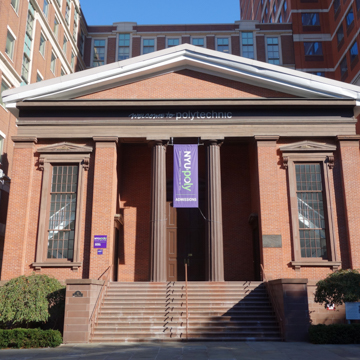Wunsch Hall, New York University
The former Bridge Street African Wesleyan Methodist Episcopal Church was an important center for New York’s Black community in the period before and during the American Civil War. Its official association with the African Methodist Episcopal (AME) Church solidified New York as a branch for Black American culture during the church’s early years and exemplified the AME Church’s geographical reach. Significantly, this church was a destination on the Underground Railroad and was central to the abolition movement in New York. Today the building is owned by New York University.
In 1817 the Black Methodists who attended Brooklyn’s First Methodist Episcopal Church withdrew from the congregation after the White elders demanded that the Black congregants pay $10 quarterly to worship in segregated galleries. At this time, independent Black churches were beginning to form and establish separate places of worship, specifically the AME Church, which was officially established in 1816 in Philadelphia at Mother Bethel AME Church. On May 14, 1817, former church members held a meeting to raise funding for their own house of worship, holding a rally that garnered $130 towards the building project, and sent a delegation to Philadelphia the following year to join the AME Church. In 1819, the church purchased property nearby on Brooklyn’s east side and built the first African Wesleyan Methodist Episcopal church. By 1840, the congregation had increased to almost 200 members and the church bought property originally owned by the First Congregational Church at 309 Bridge Street for $12,000.
The two-story brick church with brownstone base was built in the then popular Greek Revival style. The entrance facade features a pedimented portico with two wooden Doric columns marking a central doorway. Two large, ornamented windows, flanked by brick pilasters, mark either side of the entryway, which is accessed via a flight of brownstone stairs. On the north and south sides of the building are three double-hung windows on each floor, although these are largely obscured by more recent construction.
In 1938, the congregation moved from Bridge Street to 277 Stuyvesant Avenue, onto property purchased from the Grace Presbyterian Church. During a period of large-scale development in Downtown Brooklyn in the 1980s and 1990s, the Bridge Street church became part of the MetroTech Center (now Brooklyn Commons) office complex, a 16-acre superblock. Unlike many of its neighbors, the church was spared demolition and listed on the National Register of Historic Places in 1981. It served for a time as an annex for New York University’s Tandon School of Engineering but is now known as Wunsch Hall, home to the university’s admissions office and center for career development. In 2016, Matiz Architecture and Design restored the exterior and replaced the windows.
References
“History of Bridge Street African Wesleyan Methodist Episcopal Church.” Bridge Street African Wesleyan Methodist Episcopal Church, n.d. http://www.bridgestreetbrooklyn.org.
Writing Credits
If SAH Archipedia has been useful to you, please consider supporting it.
SAH Archipedia tells the story of the United States through its buildings, landscapes, and cities. This freely available resource empowers the public with authoritative knowledge that deepens their understanding and appreciation of the built environment. But the Society of Architectural Historians, which created SAH Archipedia with University of Virginia Press, needs your support to maintain the high-caliber research, writing, photography, cartography, editing, design, and programming that make SAH Archipedia a trusted online resource available to all who value the history of place, heritage tourism, and learning.














